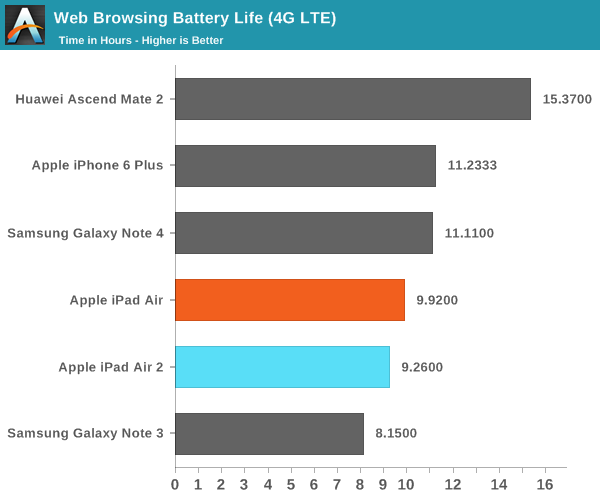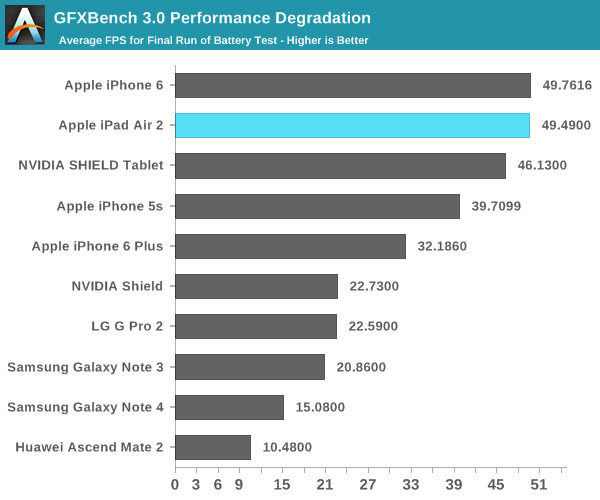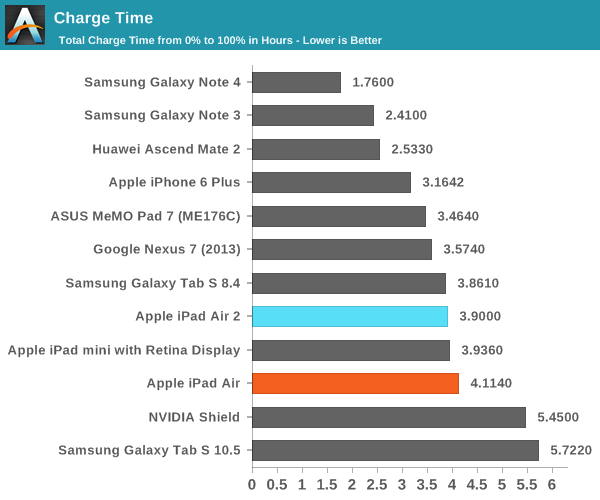The Apple iPad Air 2 Review
by Joshua Ho on November 7, 2014 9:30 AM EST- Posted in
- Tablets
- Apple
- Mobile
- iOS
- ipad Air 2
Battery Life
With the move from featurephones to smartphones, battery life has been and continues to be a critical issue. While it wasn’t unusual to see a week or more of battery life on a featurephone, some of the earliest smartphones couldn’t even last a day. While tablets seem to have a much easier time achieving high levels of battery life by virtue of massively increased volume, they still face similar issues as they are often used for gaming or other more intensive workloads that a smartphone is unlikely to see nearly as often. In order to test this, we run our tablets through a standard suite of tests of various use cases. In all cases where the display is on, all displays are calibrated to a brightness of 200 nits to draw useful relative comparisons.

In our first test, we see that the iPad Air 2 is about roughly equivalent to the original iPad Air for WiFi web browsing. This is actually a bit surprising as the battery in the iPad Air 2 is approximately 84% of the iPad Air. This would mean that we would expect the iPad Air 2 to get around 8.4 hours of battery life in this test, which represents a 16% gain to efficiency. It’s likely that these improvements to battery life come from the new process node on the A8X, along with the newer WiFi module.

Along the same lines, the LTE web browsing test tracks quite closely but it seems that there’s a minor decrease in efficiency gains when compared to WiFi. This difference is likely to be explained by the much higher bandwidth available in WiFi when compared to LTE.
While the web browsing tests are effective at ensuring faster SoCs aren’t punished, this inherently tilts battery life towards a more display-bound mode rather than compute-bound. Unfortunately short of a jailbreak it doesn’t seem possible to get an effective Basemark OS II battery test, so we’re mostly limited to a test of GFXBench’s unlimited rundown.


As one can see, the iPad Air 2 is one of the best performers on this test, considering its frame rate and runtime. While NVIDIA's GK20A GPU in Tegra K1 can get close to the GX6650 for short periods of time, over a long workload it's pretty clear that the GX6650 on 20nm has better sustained performance and significantly superior efficiency as it doesn't throttle until the 200th iteration of the test. It's important to note that the iPad Air 2 is running at a higher native resolution here, so relative to SHIELD Tablet a scaling factor needs to be estimated in order to get an idea for performance at the same resolution. During this test I saw that the skin temperatures never exceeded 45C, so this isn't the result of Apple choosing to run the device hotter than most.
Charge Time
While tablets deliver some great battery life in general, charge time tends to be much slower than that of smartphones as the battery is much larger and charging the device isn't as time critical due to the longer battery life . While we can't quite cover the full range of battery life uses cases, it's important to remember that in cases where the platform is otherwise identical beyond display that battery life scales linearly with overall capacity. In order to test charge time, we measure the time it takes for the battery to reach 100% from a fully-depleted state.

As one can see, the smaller battery seems to have a noticeable impact on charge time, although the difference isn't really all that notable as the difference is only around ten minutes at the end of the day.











226 Comments
View All Comments
Speedfriend - Friday, November 7, 2014 - link
When I read about the A8, it make me wonder about the A7. With the A8 Apple claims to have improved energy efficiency over the A7 by 50%. Now a iPhone 6 Plus driving a 1920x1020 screen has the same 10 hour battery life as a Galaxy Note 3 which also has a 1920 x 1080 screen. But that means that if Apple had tried to build a phablet with the A7, they would have ended up with a battery life of around 6.5 hours, clearly not competitive with Samsung’s offerings.So to me it looks like Apple didn’t build a bigger screen phone before not because they didn’t feel there was demand but because they simply wouldn’t have been able to compete on battery life and that is why the whole focus with the A8 was improving efficiency rather than simply performance.
So was the A7 just very uncompetitive to other ARM designs or is iOS inefficient compared to Android.
I would love to see someone do some digging on this – Anandtech?
dmunsie - Friday, November 7, 2014 - link
I don't think this has anything to do with either the A7 design or iOS -- there are too many variables in the equation to definitively say. Plus unlike other ARM designs and Android, there is only one source for the A7 and iOS -- Apple. So you can't just take iOS and install it on the same hardware as another Android device and compare.The A7 was also used in the iPad and iPad mini last year where it got an advertised 10 hour battery life. If Apple had made a Plus sized iPhone last year, they probably would've had to make it thicker to get to their target battery life, which is probably similar to what Samsung has done with their designs. Apple never likes to go thicker if they can avoid it.
You can see how Apple values size over battery life because with the move to the A8X, the Air 2 got thinner with the same battery life vs staying the same size but with more battery life. Not saying that valuing battery live over size is better than what Apple chose, but they are clearly making it known what they are optimizing for here.
Impulses - Friday, November 7, 2014 - link
As an Android fan, I'd love to see Apple stop chasing thinness and actually improve battery life by a large degree... They could've done so with the iPhone 6 and chased the claim of "2 day battery life", but they chose thinness instead.Having Apple claiming two day battery life on a phone and destroying everything else by a large margin would definitely light a fire under everyone... Over engineering for 7mm thickness vs 8.5 mm seems quite pointless to me, anything under 9 is quite enough on a phone.
It seems structurally speaking they're better off to, e.g. bendgate...
sonicmerlin - Friday, November 7, 2014 - link
Personally I'd like my phone to be as thin as a credit card.akdj - Thursday, November 27, 2014 - link
Be state came and went in ten minutes. It's a non issueMight check those up times on the 6+ again. They reflect almost identical performance as mine. I could go two days, easily.
Speedfriend - Monday, November 10, 2014 - link
Except the note and the iPhone 6+ have the same size battery, so samsung hasn't had to use a bigger battery to get the same battery life.techconc - Friday, November 7, 2014 - link
You "analysis" fails to consider the size of the battery in existing devices as part of the equation. Likewise, your conclusion regarding the A7 design not being competitive is completely baseless. What's more, you also fail to consider the manufacturing process as a variable as well. The primary efficiency difference between the A8 and A7 has much more to do with the manufacturing process moving from 28nm to 20nm.Finally, if you wish to compare Apple's chips with the competition or iOS vs. Android in terms of efficiency, you should ask yourself why Android phones require more memory to perform the same tasks and why Android devices need such a bigger battery in order to get the same level of usage and/or performance.
Speedfriend - Monday, November 10, 2014 - link
At techconcBattery size is almost identical. Manufacturing process has absolutey nothing to do with it. Or the efficiency difference between A8 and A7. It is a fairly simply equation - at same battery size, A8 equipe diPhone 6+ gives smae battery life as Note 3/4. Swap out A8 for A7 and you would get 1/3 less battery life based on Apple's 50% A8 over A7 efficiency claim. Hence why no big iPhone before.
tipoo - Friday, November 7, 2014 - link
Yup, when I saw the teardown with two RAM banks rather than the usual one, I was expecting 25.6GB/sec, with double the pins/bits going into the SoC. And it also makes sense with the huge GPU gains, something has to feed that beast. Crazy, that's now in laptop bandwidth range.cynic783 - Friday, November 7, 2014 - link
and we made it about 10 comments before the "Anand is an Apple shill" accusation lol. so much Android butt hurt.